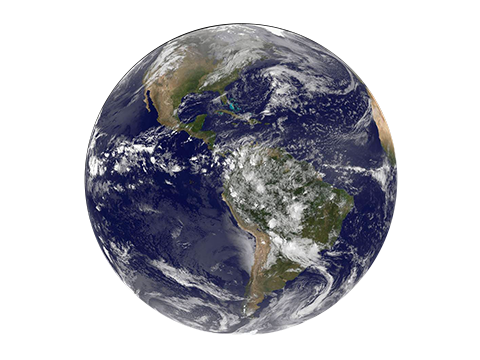Earth Facts
Planet Profile
| Type | Terrestial |
| Age | 4.543 billion years |
| Lenght of Year | 365 days |
| Moon | 1 |
| Diameter | 12,742 km, avg. |
| Mass | 5.97×1024 kg |
| Volume | 2.59876×1011 mi3 |
| Orbit Speed | 18.5 mi/s, avg. |
| Circumference | 40,075.017 km, equator |
| Dist. from Sun | 150 million km, ave |
Below are some of the facts about planet Earth:
- The earth is the third planet in the solar system and is made up of rock, and a hard surface thus being one of the 4 terrestrial planets in the solar system which consists of Mercury, Venus and Mars.
- Earth is the fifth largest planet in the solar system.
- The name Earth is at least 1,000 years old. It is an English/German word, which simply means the ground.
- The shape of the earth is not exactly a sphere. The earth is more bulging in the middle with greater circumference along the equator than the circumference across the two poles. The circumference at the equator is 40075 kilometers.
- The earth is the only planet in the solar system to have free water, free oxygen in the atmosphere which made life exist here.
- The Earth is closest to the Sun in January and furthest away in July.
- As you are in contact with the earth’s surface which is spinning in its orbit too fast, you too are also spinning with the earth may be at around a speed of 1000 miles/hr or faster. But your body has adjusted to the frequency and you will never realize this.
- The earth is always in a dual movement. While it’s spinning at a fast pace around its center, it’s also moving at a high speed through its orbit around the sun. While it spins around itself it completes a day of 24 hours, and while it completes a rotation around the sun it completes a year of 365 days.
- The earth rotates in its orbit at a speed of 107826 km/hr.
- The age of the earth is 4.54 billion years, and it is as old as the meteors in the solar system.
- Rocks on the earth get recycled in kind of a circle through years and ages. Igneous rocks are formed when magma deep inside the earth’s core comes out and hardens. And then with time and erosion bits of these igneous rocks gets deposited and pressurized to form sedimentary rocks, which gets buried deep to form metamorphic rocks. Again metamorphic rocks may get molten as magma and come to surface.
- The main elements forming the physics of the Earth are Magnesium, Iron, Silicon and Oxygen. While the total iron percent is 32.1% of all, iron at the core is more concentrated, and the core is made of almost 88% iron. Again the atmosphere and habitable zone is made of 47% oxygen while the total oxygen constituent is actually 30.1%.
- Antarctica is the coldest place on earth where temperatures may go below 73 degrees C. the lowest recoded temperature however came from Russia Vostok Station in 1983, 21 July, when temperatures dropped to 89.2 degrees C.
- 70% of the earth’s store of fresh water is in the ice cap in Antarctica. Also 90% of the earth’s ice lies there too.
- The gravity on earth is not the same everywhere as because the earth is not a perfect sphere. In the equator the gravity is lower than that in the poles. Also an area in Canada in the Hudson Bay records lower gravitational pull than average.
- The earth has a magnetic field which earlier shifted every year at a rate of 10 miles per year from the North Pole. But recently the migration of the North Pole has accelerated to a rate of 40 miles each year thereby changing the magnetic field orientation and its strength at places.
